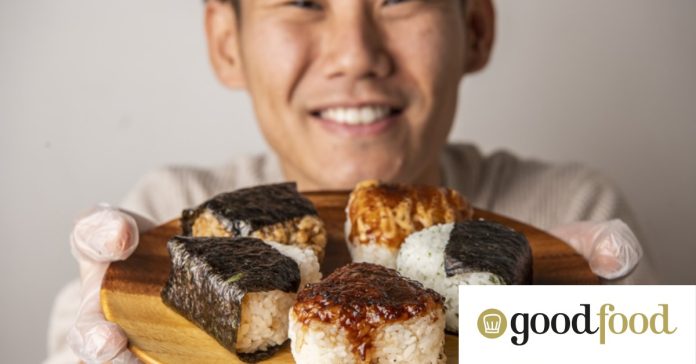[ad_1]
Japan’s “soul food” is creeping onto Sydney cafe menus and into convenience store fridges. And these rice balls have a few bonuses that our beloved handrolls don’t.
Despite spending a year searching for the perfect rice, Kantaro Okada could not make any money at his Japanese cafe selling onigiri, the rice balls with various fillings that are as common in Japan as sandwiches are here.
“We were in the red. We couldn’t break even for the first six months,” says Okada.
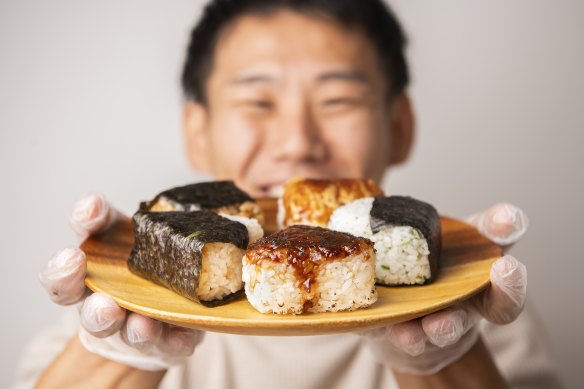
That was five years ago. Now, his North Melbourne cafe, 279, is one of about a dozen casual spots in Melbourne and Sydney offering onigiri, once only found at a handful of Japanese restaurants in Australia and now part of a new wave of Japanese convenience food.
Onigiri are made by moulding warm rice around a variety of fillings into the shape of a ball or triangle and wrapping it in a piece of nori (seaweed).
While still seen as a speciality item, onigiri taps into Australians’ love of hand-held, takeaway sushi and has the potential to become just as loved.
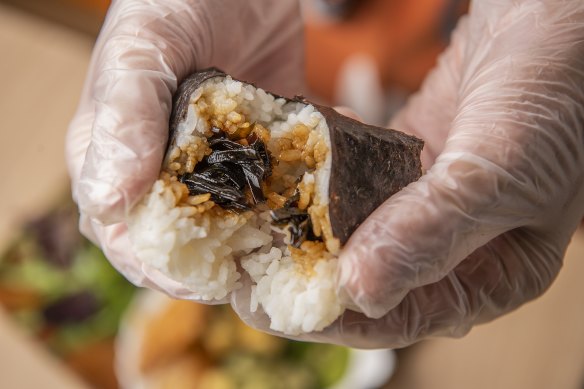
In fact, onigiri are served and eaten in Japan in a similar way to our sushi rolls. They’re portable, widely available, a speedy yet healthy lunch, and a favourite of both children and adults.
“For Japanese people, I believe the soul food is onigiri,” says Yu Ozone, co-owner of Comeco Foods in Sydney’s Newtown. “Japanese people eat onigiri as a meal and also as a snack. It’s like the sandwich for Australians.”
Onigiri have an edge over sushi rolls and that other grab-and-go lunch, the sandwich, for several reasons.
Firstly, they’re healthier because the rice isn’t seasoned with sugar, vinegar or salt, unlike sushi rice. The rice for onigiri only requires salt.
Secondly, many onigiri are fresher. Most spots offering onigiri make each rice ball to order, for only a few more dollars than your average food court sushi roll.
Finally, onigiri are gluten-free and yet are still very filling compared to salads and other common gluten-free lunches.
Five onigiri essentials to know
- No chopsticks required – just pick it up and eat it with your hands.
- It’s gluten-free
- Unlike sushi rolls, there’s no sugar (or vinegar) in the rice
- Traditional Japanese fillings include furikake, a crunchy mix of sesame seeds, seaweed, dried fish flakes and other salty sprinkles, or the more powerful umeboshi (pickled plum). Somewhere in between are cooked salmon, soy-marinated seaweed, or mentaiko and tarako (types of cod roe).
- Grab and go – they’re as portable as a sandwich, but remember the longer the seaweed is in contact with the rice, the softer it gets.
The other bonus is that onigiri are much cheaper than the tricked-up sandwiches now taking Melbourne and Sydney by storm.
Onigiri Kitchen in Melbourne has found so much success with its first store on Little Collins Street and its office catering that it’s set to grow to four locations by the end of the year, including one on popular Degraves Street, once a hub for espresso bars and French-style cafes.
Okada and Ozone think that the increasing number of Australians travelling to Japan is a big part of the food’s current popularity here.
“If you’ve been to Japan and you’ve been to a convenience store, it’s hard to miss onigiri. I’d be surprised if someone hadn’t tried it,” Okada says.
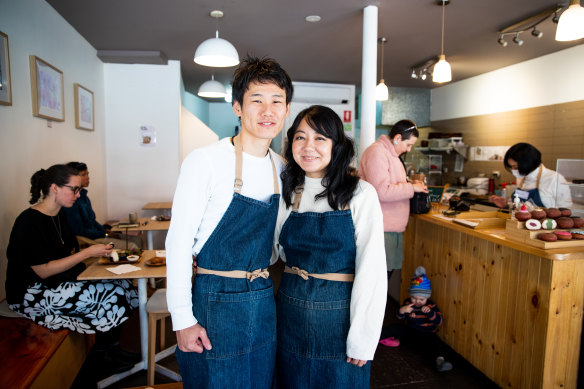
The secret to good onigiri is good rice. You want “soft and fluffy cooked rice with a non-sticky surface that crumbles gently when bitten into, with just the right amount of saltiness,” says Ozone.
In its quest for the perfect grain, 279 cafe trialled 20 varieties of rice and 10 different rice cookers, and it continues to test and tweak to this day.
The businesses spoken to for this article use quality varieties such as masshigura or koshihikari, both highly ranked by the Japan Grain Inspection Association.
Traditional onigiri fillings usually include pickled or preserved ingredients, such as umeboshi (a salted, intensely sour plum) or takana (lightly pickled greens). Western-influenced fillings include tuna with mayonnaise or even fried chicken.
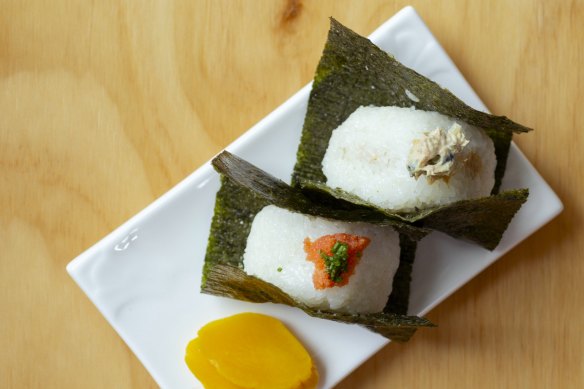
If some of these sound like what you’d put in a sandwich, the similarities don’t end there. Onigirazu is an onigiri spin-off that looks like a sandwich using rice instead of bread, with a nori (seaweed) wrapping around the outside.
Kaede cafe in Abbotsford, Melbourne, has been serving onigirazu since 2021. Owner Yuki Murata says they’re the perfect bridge between Australia and Japan because they have more filling and less rice.
Other venues, including Domo 39 and Kura Kura in Sydney and Onigiri Kitchen in Melbourne, are trying to recreate the true Japanese convenience store experience by using the same triangular packaging for onigiri or grab-and-go fridges.
Five places to find onigiri in Sydney
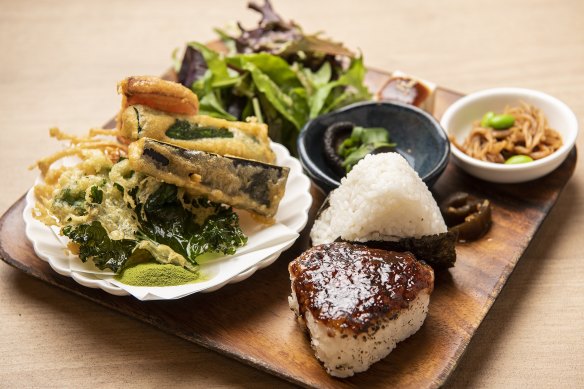
Comeco, Newtown
Everything is gluten-free, plant-based and delicious at this small Japanese cafe, listed among Sydney’s best in The Sydney Morning Herald Good Food Guide. Onigiri made with koshihikari rice come as part of a lunch set, served with crunchy tempura vegetables or grilled teriyaki tofu. Choose from miso-grilled onigiri, umeboshi or the two weekly specials.
524A King Street, Newtown, comecofoods.com.au
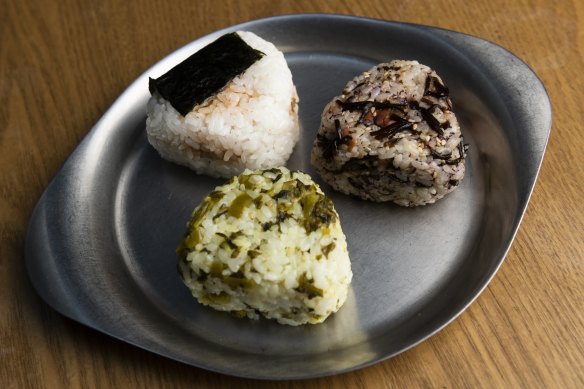
Parami, Sydney
Parami co-owner Mika Kazato says the Japanese ritual of picking up onigiri from a 7-Eleven fridge inspired the concept for her cafe. The ex-Aria chef makes vividly coloured onigiri, sprinkled with shreds of tart umeboshi (sour plum) and salty-sweet shiso power, or brimming with bright, pickled mustard greens. It’s also a must-try for tea lovers, with hard-to-find brews like the umami-driven gyokuro from Uji, Kyoto.
Shop 101/21 Alberta Street, Sydney, instagram.com/parami_alberta
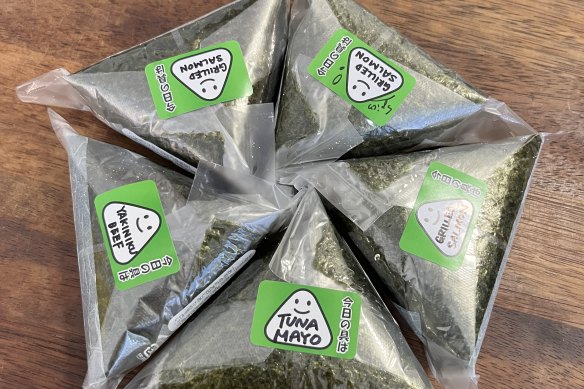
Miso Mart (Cafe Maru), Crows Nest
Affordable and plentiful onigiri come in more than 15 varieties at this Japanese convenience store. From $4.50 (takeaway), there’s spicy yakiniku beef, the best-selling zuke (mirin marinated) salmon and more. Pick one up on the way to the nearby train station or head to their cafe across the road, Cafe Maru, where you can eat onigiri and have your car washed at the same time (it’s hidden inside Snap Car Wash).
105/545-553 Pacific Highway, St Leonards, misomart.com.au
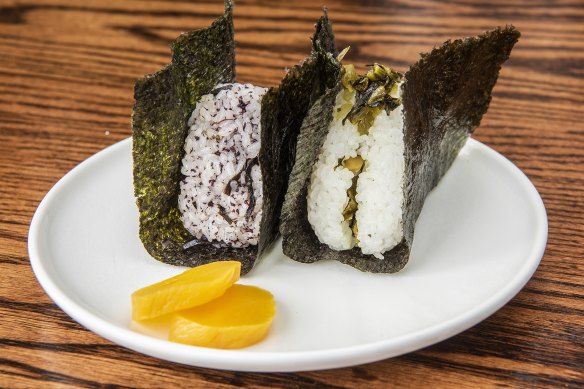
Domo 39, St Peters
Onigiri are available pre-packaged for convenient grab-and-go at Domo 39, but they’re best when made-to-order, when the rice is warm, and the nori is still crisp. Choose from six fillings, including vegetarian-friendly shiso kombu (kelp) and creamy tuna and mayo. Pick up some “rice’ cream while you’re there, a toasted rice soft-serve from Mapo Gelato’s Matteo Pochintesta.
5/2 May Lane, St Peters, instagram.com/domothreenine
Kura Kura Onigiri, Haymarket
A year ago, this popular Japanese restaurant started selling onigiri, bento boxes and affordable rice bowls at lunchtime on weekdays from a small stand near the entry to the restaurant. Wrapped just like they are in Japan’s convenience stores, the rice balls come in Aussie-tinged flavours like teriyaki chicken alongside more classic mentaiko (marinated cod roe) or salted salmon.
76 Ultimo Road, Haymarket, instagram.com/kurakura_onigiri/
Restaurant reviews, news and the hottest openings served to your inbox.
From our partners
[ad_2]
Source link


